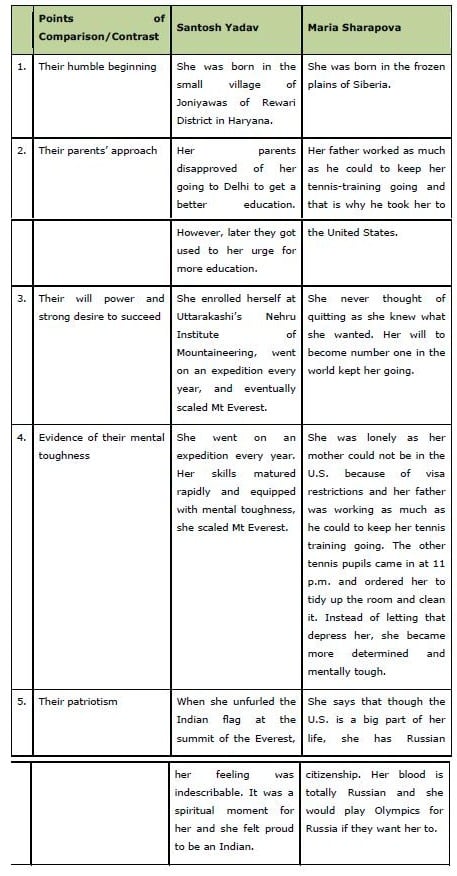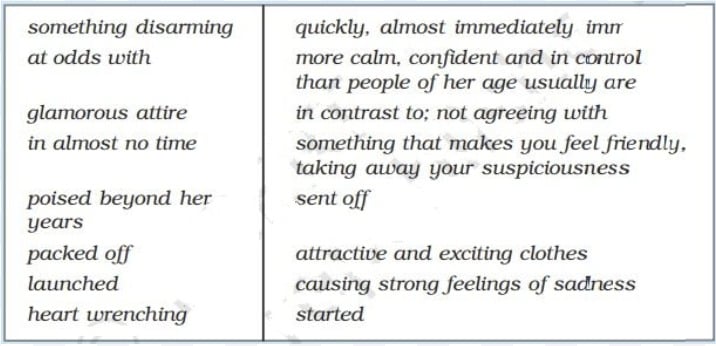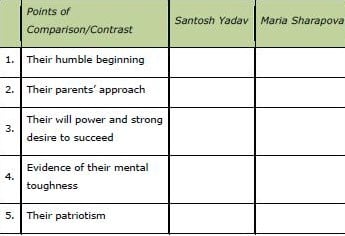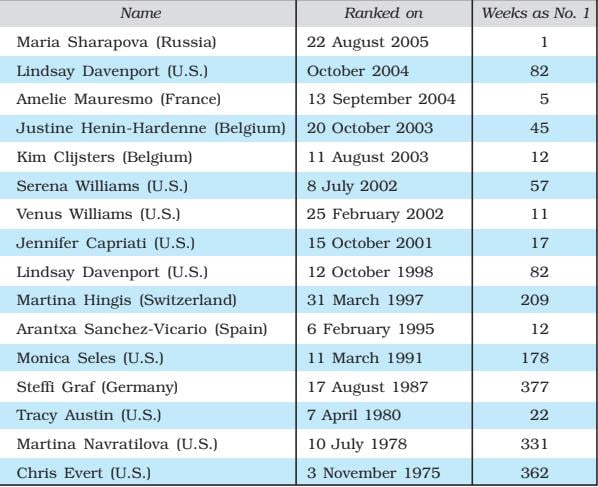Chapter - 8 "Reach for the Top"
Q.1: Think for a while and make a list of three to five persons you idolise, or admire very much for their achievements. Your idols may be from any sphere of life — sports, medicine, media, or art and culture.
Ans : DIY
Q.I.: Answer these questions in one or two sentences each. (The paragraph numbers within brackets provide clues to the answers.)
1. Why was the ‘holy man’ who gave Santosh’s mother his blessings surprised? (1)
2. Give an example to show that even as a young girl Santosh was not ready to accept anything unreasonable. (2)
3. Why was Santosh sent to the local school? (3)
4. When did she leave home for Delhi, and why? (4)
5. Why did Santosh’s parents agree to pay for her schooling in Delhi? What mental qualities of Santosh are brought into light by this incident? (4)
Ans : 1. The 'holy man' was surprised because he had assumed that Santosh's mother wanted a son. However, the unborn child's grandmother told him that they did not want a son. 2. Santosh began living life on her own terms from the start. Where other girls wore traditional Indian dresses, Santosh preferred shorts. 3. Even though Santosh's parents could afford to send their children to the best schools, she was sent to the local village school due to the prevailing custom in the family. 4. When she turned sixteen and was under pressure to get married, Santosh threatened her parents that she would never marry if she did not get a proper education. Therefore, she left home and got herself enrolled in a school in Delhi. 5. When Santosh's parents refused to pay for her education, she politely informed them of her plans to earn money by working part time to pay her school fees. Then, her parents agreed to pay for her schooling in Delhi. This shows that Santosh was a mentally-strong girl and was ready to work very hard to get herself properly educated.
Q.II: 1. How did Santosh begin to climb mountains?
2. What incidents during the Everest expedition show Santosh’s concern for her team-mates?
3. What shows her concern for the environment?
4. How does she describe her feelings at the summit of the Everest?
5. Santosh Yadav got into the record books both times she scaled Mt Everest. What were the reasons for this?
Ans : 1. From her room in Kasturba Hostel, she watched people going up the Aravalli Hills and vanishing after a while. On investigating, she found certain mountaineers, whom she later accompanied in their climbing expedition. This was how she began climbing mountains. 2. During the Everest mission, Santosh helped a dying climber, but she was unsuccessful in saving him. However, she managed to save another climber, Mohan Singh, by sharing her oxygen with him. These incidents show her concern for her team-mates. 3. Santosh was a fervent environmentalist. She collected and brought down 500 kilograms of garbage from the Himalayas. 4. Santosh says that the feeling at the summit of the Everest was indescribable. Unfurling the Indian flag on the top of the world was a spiritual moment for her. She felt proud as an Indian. 5. When Santosh Yadav first scaled Mt Everest, she became the youngest woman in the world to achieve the feat. On repeating this feat, she became the only woman to have scaled the Everest twice.
Q.III: Complete the following statements.
1. From her room in Kasturba Hostel, Santosh used to________________
2. When she finished college, Santosh had to write a letter of apology to her father because_____________
3. During the Everest expedition, her seniors in the team admired her__________ while__________ endeared her to fellow climbers
Ans : 1. From her room in Kasturba Hostel, Santosh used to watch villagers going up the hill and suddenly vanishing after a while. 2. When she finished college, Santosh had to write a letter of apology to her father because she had got herself enrolled at Uttarkashi Nehru Institute of Mountaineering without his permission. 3. During the Everest expedition, her seniors in the team admired her climbing skills, physical fitness and mental strength while her concern for others and desire to work together with them endeared her to fellow climbers.
Q.IV: Pick out words from the text that mean the same as the following words or expressions. (Look in the paragraphs indicated.)
1. took to be true without proof (1):_____________
2. based on reason; sensible; reasonable (2): _____________
3. the usual way of doing things (3): _______________
4. a strong desire arising from within (5): _________________
5. the power to endure, without falling ill (7): _______________
Ans : 1. took to be true without proof (1): Assumed 2. based on reason; sensible; reasonable (2): Rational 3. the usual way of doing things (3): Custom 4. a strong desire arising from within (5): Urge 5. the power to endure, without falling ill (7): Resistance
Q.1: A Russian girl, Maria Sharapova, reached the summit of women’s tennis when she was barely eighteen. As you read about her, see if you can draw a comparison between her and Santosh Yadav.
Ans : DIY
Q.2:
Ans :
Q.3: As you read, look for the answers to these questions.
(i) Why was Maria sent to the United States?
(ii) Why didn’t her mother go with her?
(iii) What are her hobbies? What does she like?
(iv) What motivates her to keep going?
Ans : (i) Maria was sent to the United States for her tennis training. That trip to Florida with her father launched her on the path to success and stardom. (ii) Her mother could not go with her because of visa restrictions. (iii) Her hobbies are fashion, singing and dancing. She likes reading the novels of Arthur Conan Doyle. On the one hand, she is fond of sophisticated evening gowns and on the other, of pancakes with chocolate spread and fizzy orange drinks. (iv) Apart from money, the motivation to become the number one in the world keeps her going.
Q.1: Working in small groups of 4–5 students, go back over the two passages on Santosh Yadav and Maria Sharapova and complete the table given below with relevant phrases or sentences
Ans :
Q.I: Identify the two parts in the sentences below by underlining the part that gives us the information in brackets, as shown above.
1. Where other girls wore traditional Indian dresses, Santosh preferred shorts. (Contrasts her dress with that of others) 2018-19 108 / Beehive
2. She left home and got herself enrolled in a school in Delhi.(Tells us what happened after the first action.)
3. She decided to fight the system when the right moment arrived.(Tells us when she was going to fight the system.)
4. Little Maria had not yet celebrated her tenth birthday when she was packed off to train in the United States. (Tells us when Maria was sent to the U.S.)
Ans : 1. Where other girls wore traditional Indian dresses, Santosh preferred shorts. 2. She left home and got herself enrolled in a school in Delhi. 3. She decided to fight the system when the right moment arrived. 4. Little Maria had not yet celebrated her tenth birthday when she was packed off to train in the United States.
Q.II: Now rewrite the pairs of sentences given below as one sentence.
1. Grandfather told me about the old days. All books were printed on paper then.
2. What do you do after you finish the book? Perhaps you just throw it away.
3. He gave the little girl an apple. He took the computer apart.
4. You have nothing. That makes you very determined.
5. I never thought of quitting. I knew what I wanted.
Ans : 1. Grandfather told me about the old days when all books were printed on paper. 2. After finishing the book, perhaps you just throw it away. 3. He gave the little girl an apple and took the computer apart. 4. Having nothing makes you very determined. 5. I never thought of quitting as I knew what I wanted.
Q.I: Working in pairs, go through the table below that gives you information about the top women tennis players since 1975. Write a short article for your school magazine comparing and contrasting the players in terms of their duration at the top. Mention some qualities that you think may be responsible for their brief or long stay at the top spot.Top-Ranked Women Players The roll of honour of women who enjoyed life at the summit since everybody’s favourite player, Chris Evert, took her place in 1975.
Ans : DIY
Q.II: Which of these words would you use to describe Santosh Yadav? Find reasons in the text to support your choices, and write a couple of paragraphs describing Santosh’s character.
Ans :
Q.1: Can a “simple jab of the knife” kill a tree? Why not?
Ans : No, a simple jab of knife does not have the ability to kill the tree. It has to go through various processes. If its root is not removed from the earth, it will sprout again.
Q.2: How has the tree grown to its full size? List the words suggestive of its life and activity.
Ans : The tree consumes the earth, and rises out it feeding upon its crust. It absorbs years of sunlight, air and water.
Q.3: What is the meaning of “bleeding bark”? What makes it bleed?
Ans : 'Bleeding bark' means the twigs which are cut mercilessly. They leave a liquid substance. If any part of the human body is cut, it starts bleeding. In the same way the liquid substance comes out from the branch of a tree. The human beings' axe makes it bleed
Q.4: The poet says “No” in the beginning of the third stanza. What does he mean by this?
Ans : 'No' is used to emphasize the perspective that chopping or hacking will not be sufficient for killing a tree.
Q.5: What is the meaning of “anchoring earth” and “earth cave”?
Ans : It means that the earth protects it like a mother. 'Earth Cave' implies a hole inside it. The tree allows its roots to spread underneath. The earth protects it and fosters t It provides all the essential ingredients to the tree.
Q.6: What does he mean by “the strength of the tree exposed”?
Ans : The stem/root is the strength of a tree. When the tree is pulled out, its strength is exposed.
Q.7: What finally kills the tree?
Ans : Pulling out the tree from the mother earth and scorching and choking it in the sun and air kill the tree. It becomes brown, dry and gets hard. Eventually it dies.




No comments:
Post a Comment